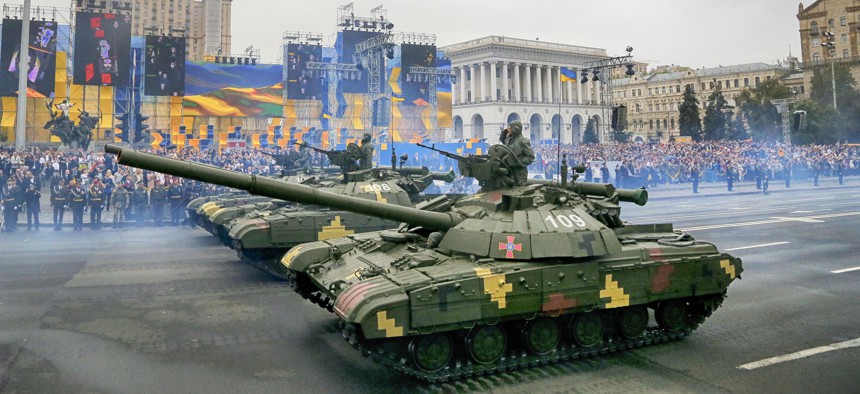
Tanks ride along Khreshchatyk Street, during a military parade to celebrate Independence Day in Kiev, Ukraine, Wednesday, Aug. 24, 2016. AP Photo/Efrem Lukatsky
Ukraine Is Losing Fewer Weapons to Theft, but High-Level Corruption Persists
A member of the Independent Defence Anti-Corruption Committee says the international community must leverage its security aid to force reforms.
Ukraine’s defense and security leaders must be breathing a sigh of relief following Rex Tillerson’s early-July visit to Kyiv. Despite early fears that the Trump administration would attempt a Russian-American reset, the U.S. Secretary of State pledged to maintain sanctions on Russia. It is, however, not just Moscow that threatens the integrity of Ukraine’s institutions and the security of its borders.
Tillerson highlighted the importance of tackling corruption in a July 9 joint briefing with Ukrainian President Petro Poroshenko – and though he emphasized the problems in the judiciary, security assistance must not have been far from his mind. This kind of aid from the international community has helped build better and more accountable security forces, but with Ukraine rated as “high risk” by Transparency International’s Government Defence Anti-Corruption Index, is it being used effectively?
As one of three international members of NAKO, the Independent Defence Anti-Corruption Committee set up by TI to oversee defense reform in Ukraine, I helped assess how corruption affects the provision of security assistance to the country. We found that while security assistance is now better monitored on the ground at the tactical level, problems persist at the strategic level. Unnecessary secrecy at this level, where security needs are articulated, limits the ability of donors – and the Ukrainian public – to understand how defense funds are being allocated and spent.
When war first broke out in Eastern Ukraine, there were reports of international assistance being waylaid through theft and reselling. In some cases, donor governments opted to rely on volunteers to deliver winter boots, night-vision goggles, and protection gear to frontline troops. Since 2014, the urgency of the situation and more stringent donor requirements have encouraged Ukrainian MoD to put in place more robust monitoring and reporting programs. The Ukrainian Armed Forces has improved its tracking of security assistance, making large-scale misappropriation and black market sales much more difficult.
But serious problems still persist at the strategic level. While new monitoring procedures create confidence that arms and gear get where they are supposed to go, it is far less clear that these items are really what Ukraine needs to fight the war. Military procurement and acquisition planning processes remain completely opaque, and raise questions about their effectiveness. The most important planning documents in Ukrainian state procurement are classified, including the State Defence Order, the annual procurement plan for arms and defense equipment; and the Priority Directions, which outlines security-assistance needs.
Meanwhile, Ukraine’s state-owned defense industrial giant Ukroboronprom remains an enigma. One interviewee noted that “they’re so big and so protected that when it comes to some decisions, people defer to them.” Research suggests that the MoD might base its requirements not on a needs assessment, but rather on Ukroboronprom’s ability to produce particular items – which is the opposite of what should occur.
In short, progress on operational and tactical levels has not been matched by similar progress at the strategic level. For donors, this means less confidence that the requirements they see or are given reflect real needs, and less confidence that the equipment they provide can be used effectively. Donors should use their influence to insist on systemic reform of Ukrainian defense governance. Some donors have tried to use conditionality arrangements to incentivize reform, but they have struggled to do it effectively. For example, the U.S. set anti-corruption conditions in the 2017 National Defense Authorization Act, but the conditions were unclear and allowed only a matter of weeks to delay the funding and force through reforms. This is insufficient to bring about change. If donors set clear standards on defense anti-corruption reform for expanded or continued security assistance support, it would create an important incentive for defense leaders to accept much-needed reforms.
Donors should also support an amendment to Ukraine’s “On State Secrets” law to allow more information to become available either to the public or – should security conditions prevent this – to security-cleared members of Parliament and audit institutions. Access to key documents and planning processes would allow for greater scrutiny of how these processes work and whether they deliver what the country really needs.
Earlier this month at the Ukraine Reform Conference in London, British Foreign Secretary Boris Johnson lauded Ukraine’s anti-corruption progress but acknowledged that it might now be faltering. It is time for the international community to press harder and in new ways for transparency and accountability reforms.
NEXT STORY: Is Russia Really with Assad in Syria?